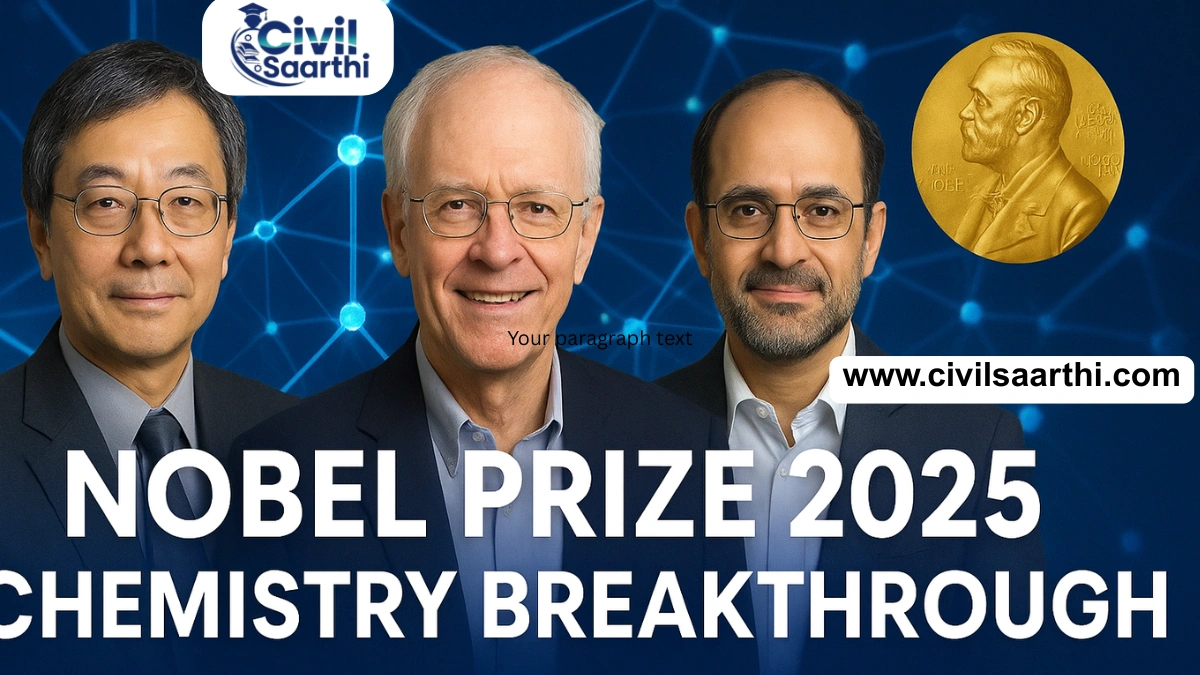The Nobel Prize in Chemistry 2025 has been jointly awarded to Susumu Kitagawa, Richard Robson, and Omar M. Yaghi for their groundbreaking development of Metal-Organic Frameworks (MOFs). These innovative crystalline materials have opened new frontiers in chemistry by providing solutions to global challenges such as carbon capture, water harvesting, and clean energy storage.
The award recognizes the transformative impact of MOFs, which have revolutionized how scientists design and utilize materials at the molecular level.
Overview of the 2025 Nobel Prize in Chemistry
Winners: Susumu Kitagawa, Richard Robson, and Omar M. Yaghi
Field: Inorganic and Materials Chemistry
Discovery: Development of Metal-Organic Frameworks (MOFs)
Announced by: The Royal Swedish Academy of Sciences
Prize Money: 11 million Swedish Kronor (shared equally)
Date of Announcement: 8 October 2025
This year’s Nobel celebrates a major leap in materials science. The laureates’ discoveries have laid the foundation for a new class of compounds that are lightweight, stable, and capable of performing complex molecular tasks once thought impossible.
What Are Metal-Organic Frameworks (MOFs)
Metal-Organic Frameworks (MOFs) are crystalline materials composed of metal ions or clusters connected by organic linkers, forming a three-dimensional porous network. These structures possess an enormous internal surface area, making them exceptionally efficient for storing, separating, and filtering molecules.
Key Features of MOFs
High Surface Area: A small amount of MOF material can have a surface area greater than that of several football fields.
Customizable Design: The size and chemistry of pores can be tailored to target specific molecules.
Lightweight and Durable: MOFs remain stable under various environmental conditions.
Environmentally Relevant: They play a crucial role in sustainability by aiding carbon capture and water purification.
Scientific Background and Development
The journey of MOFs began in the late twentieth century with the exploration of coordination networks.
Richard Robson from the University of Melbourne first proposed linking metal ions with organic ligands to create extended frameworks. His early work laid the foundation for MOF chemistry.
Susumu Kitagawa of Kyoto University demonstrated that these frameworks could be both porous and flexible, allowing gases to flow in and out of the material. This was a revolutionary discovery that proved MOFs were not only structurally interesting but also functionally powerful.
Omar M. Yaghi at the University of California, Berkeley, advanced the field by developing robust and highly stable MOFs. He introduced the concept of reticular chemistry, which allows scientists to build complex materials by connecting molecular building blocks with precision.
Together, their contributions established MOFs as one of the most versatile classes of materials in modern chemistry.
Applications of Metal-Organic Frameworks
The discovery of MOFs has vast scientific and industrial implications. These materials are being actively researched for their potential in solving real-world problems.
1. Carbon Capture and Climate Solutions
MOFs can selectively capture carbon dioxide from industrial emissions and even from ambient air. This makes them a key technology for reducing greenhouse gases and addressing climate change.
2. Water Harvesting from Air
Some MOFs can absorb water molecules from the atmosphere and release them when exposed to heat or sunlight. This innovation enables atmospheric water harvesting, providing a sustainable source of drinking water in dry regions.
3. Gas Storage and Energy Applications
MOFs can store gases such as hydrogen and methane efficiently. They are being tested for use in clean fuel technologies and energy storage systems.
4. Pollution and Wastewater Treatment
MOFs can remove toxic substances, pharmaceuticals, and PFAS chemicals from contaminated water, contributing to cleaner ecosystems and sustainable water management.
5. Catalysis and Chemical Industry
MOFs can act as catalysts for chemical reactions. Their large surface areas and tunable properties make them ideal for use in the production of pharmaceuticals and fine chemicals.
Significance of the Discovery
The 2025 Nobel Prize in Chemistry recognizes not just a discovery, but a paradigm shift in how scientists design materials. MOFs represent the triumph of reticular chemistry, which is the deliberate linking of molecular building blocks to create predictable, functional structures.
The discovery has major implications for sustainability, clean technology, and advanced manufacturing, showing how fundamental chemistry can directly improve human life.
About the Laureates
Susumu Kitagawa
Affiliation: Kyoto University, Japan
Contribution: Discovered flexible and porous coordination polymers capable of gas storage and release.
Impact: Paved the way for using MOFs in environmental and industrial applications.
Richard Robson
Affiliation: University of Melbourne, Australia
Contribution: Designed the earliest coordination networks forming the structural basis for MOFs.
Impact: Provided the theoretical foundation for linking metal ions and organic ligands.
Omar M. Yaghi
Affiliation: University of California, Berkeley, USA
Contribution: Created highly stable MOFs and established the field of reticular chemistry.
Impact: Expanded the practical applications of MOFs in sustainability and nanotechnology.
Impact on Future Research and Technology
The recognition of MOFs through the Nobel Prize is expected to influence several key areas:
Increased Industrial Use: MOFs may soon be implemented in large-scale carbon capture, air purification, and water filtration systems.
Global Collaboration: Chemists, engineers, and material scientists are likely to work together to improve MOF design and functionality.
Educational Relevance: MOFs will become a central part of advanced chemistry and materials science studies.
Innovation in Sustainability: Their applications in clean energy and environmental remediation align with the global push toward a greener planet.
Timeline of Major Milestones
| Year | Milestone |
|---|---|
| 1980s | Richard Robson develops coordination network frameworks |
| 1997 | Susumu Kitagawa demonstrates gas adsorption in flexible porous materials |
| 1999 | Omar Yaghi synthesizes the first stable and highly porous MOFs |
| 2000–2020 | Expansion of MOF research and practical testing |
| 2025 | Nobel Prize in Chemistry awarded for MOF development |
Why the Nobel Committee Selected MOFs
The Nobel Committee emphasized that MOFs are among the most transformative materials discovered in modern chemistry. Their tunable structures and ability to perform specific molecular tasks have made them indispensable in scientific research and industry.
The award underscores how creative chemistry can address real-world challenges, making MOFs an essential innovation for a sustainable future.
Conclusion
The Nobel Prize in Chemistry 2025 celebrates a scientific achievement that bridges innovation and sustainability. The discovery of Metal-Organic Frameworks (MOFs) has not only deepened our understanding of molecular structures but also provided practical tools for combating environmental issues.
This recognition marks the beginning of a new era where chemistry plays a vital role in shaping a cleaner and more sustainable future.
Frequently Asked Questions
Q1. Who won the Nobel Prize in Chemistry 2025?
Susumu Kitagawa, Richard Robson, and Omar M. Yaghi jointly received the Nobel Prize in Chemistry 2025 for their development of Metal-Organic Frameworks (MOFs).
Q2. What are Metal-Organic Frameworks?
MOFs are crystalline materials made from metal ions and organic linkers. They form porous networks capable of storing, filtering, or capturing molecules.
Q3. What is the practical use of MOFs?
They are used in carbon capture, water harvesting, gas storage, pollution control, and as catalysts in the chemical industry.
Q4. Why is this discovery important?
The discovery of MOFs has transformed materials science by offering new solutions for climate change, sustainability, and clean energy.
Q5. What is Reticular Chemistry?
It is a method of constructing materials by linking molecular building blocks into predictable and stable structures, forming the scientific basis of MOFs.
Q6. How much prize money was awarded?
The Nobel Prize carried a total award of 11 million Swedish Kronor, divided equally among the three laureates.
Q7. When was the Nobel Prize announced?
The Nobel Prize in Chemistry 2025 was announced on 8 October 2025 by the Royal Swedish Academy of Sciences.







